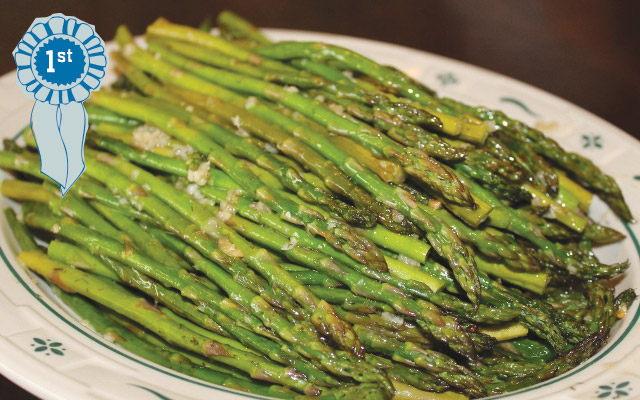The spring planting season is in full swing! Therefore, I am continuing to feature one of my favorite spring planted items (bulbs, perennials, fruits or veggies) each week. This garden selection will then become Holland Bulb Farm’s Bulb Bargain for that one day ONLY. They’ll also be featuring a unique shipping deal each week with the bargain which will also last for that one day only — it’s a great chance to try something new or stock up on one of your faves! Check back each week or sign up for their newsletter to be notified each time I feature something different!
Ah yes, fresh asparagus. While there are a few who do not care for the taste, I would venture to guess that the majority of you can’t get enough of it in the summertime. One of the first plants ready for harvesting in the spring, asparagus is a crop you can plant once and enjoy for 20 years or even more! So today, I’m featuring the Jersey Giant Asparagus, a high-yielding male variety that will knock your socks off (and tickle your taste buds).
I’ll admit, I’m relatively new to growing asparagus. However, my love for its taste, the rising prices of it in the grocery store — seriously, $4.99 a bundle??? yikes! — and the frequent questions I receive from readers have all spurred me on to become familiar with it. Therefore, I figured I’d do a quick Q & A about asparagus and specifically, growing them successfully.
Q: What is the difference between a male or female asparagus plant?
A: Asparagus are “dioecious”, meaning that each plant is either male or female. The spears of the male varieties, such as the Jersey Giant, tend to be larger in diameter and higher yielding that the female varieties, such as the Martha or Mary Washington. Some varieties contain plants of both gender, such as the Purple Passion Asparagus. While some claim that the larger spears of the male variety lack flavor or tenderness, this is actually not the case. The flavor and texture of the asparagus is actually related more to freshness and overall maturity of the plant. The reason the males have higher yields than the female varieties is due mostly to the fact that they do not produce seeds. These seeds (appearing like tiny red berries) actually require quite a bit of energy to produce, which reduces the amount of energy available for root and ultimately, spear growth. Female plants also produce seedlings at an alarming rate, oftentimes leading to an overcrowded bed of asparagus.
 Q: What is meant by an asparagus “crown”?
Q: What is meant by an asparagus “crown”?
A: The “crown” of an asparagus plant simply refers to the root system of the plant. When held right side up, these roots hang downward and are all connected at the same point which is where the sprout will emerge. This “crown” should be planted with this connection point at the soil surface.
Q: How many asparagus plants or crowns should I plant?
A: This largely depends on how much you and your family like asparagus! 😉 However, this number will also need to be adjusted based on which variety you are planning to grow. Since the male varieties produce thicker, more-filling spears, your garden will require fewer than if you are planting the thinner-speared female varieties. In general, plan on 5-8 plants or crowns per person when using a male variety and double that (10-16 crowns) if using a female type.
Q: When and how do I harvest my asparagus?
A: It is best to allow an asparagus plant to reach an age of 2-3 years prior to beginning to harvest it. Purchasing crowns from mature plants (crowns are often “sized” according to their age) will help to speed up this waiting process. If purchasing 2- or 3-year old root stock, it is still best to give these roots one full season to grow in your yard prior to harvesting.
You should then begin to see the points of the asparagus spears begin to emerge by the middle of the following spring, not long after the weather begins to be consistently warmer. The optimal time to begin cutting the spears is once they have reached 8-10″ in height. If the spears begin to open and/or starting to produce foliage, they have been allowed to grow too long and the flavor and texture will be much less desirable. I recommend still cutting these stalks while harvesting but dropping them directly into your compost pile on the way inside 😉 Because of the speed of growth, checking your asparagus bed once every other day during the growing season is completely appropriate.
Q: How long will my asparagus produce?
A: The asparagus harvesting season’s length is going to depend on the maturity of your plants. Newly planted asparagus will often produce for several weeks, whereas more fully mature asparagus can sometimes be harvested for 6-8 weeks if grown in nutrient-rich soil. You will know that you are done harvesting when the spears begin to decrease in diameter, eventually reaching the size of a pencil. Once this has occurred, cease harvesting and allow them to grow to their full height.
Q: What do I do with my asparagus plants to prepare them for winter?
A: One of the amazingly wonderful things about asparagus is that they are a fully perennial vegetable so there’s not much that is needed to be done prior to the winter months. Simply cut the plant back within 6″ of the ground once the first frost has turned it brown and wait for spring!
I just cannot say enough about the great ease and incredible rewards of growing your own asparagus! Because of the amazing flavor it adds to so many dishes, I have found that most recipes containing asparagus are relatively easy to execute. In fact, the first place winner for the veggie category in our Homegrown Recipe Contest this year submitting a recipe for Oven-Roasted Asparagus — so simple yet oh-so so so good!
So why not try your hand at growing some Jersey Giants? If you’re anything like me, you’ll wonder why you didn’t do it sooner!




